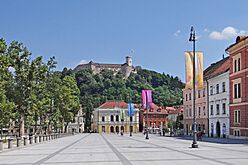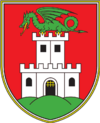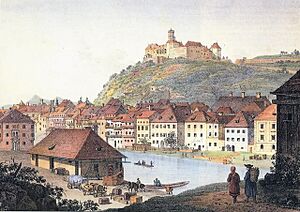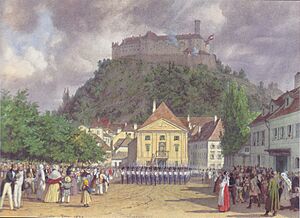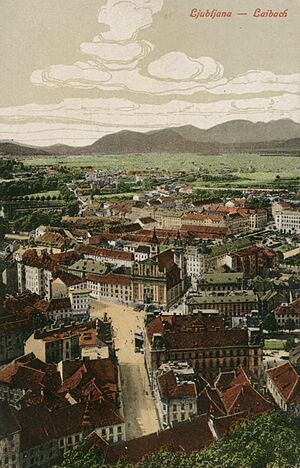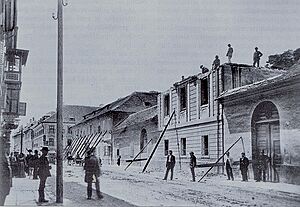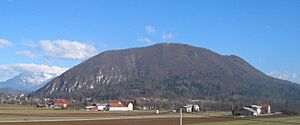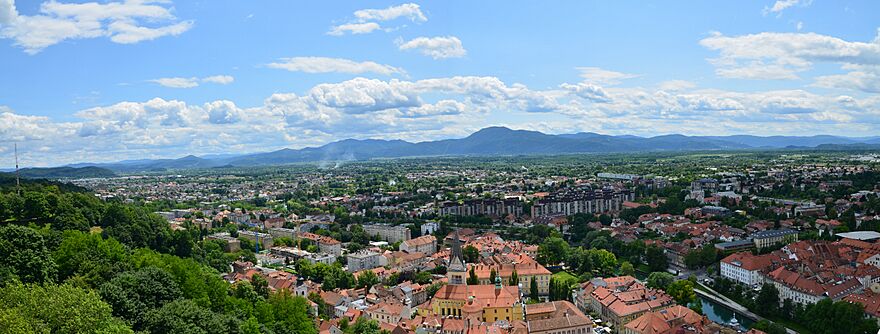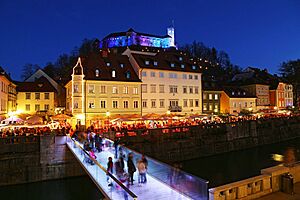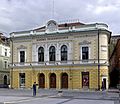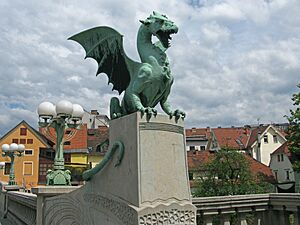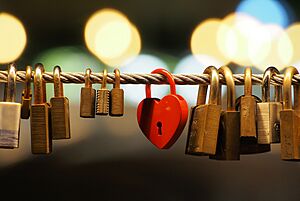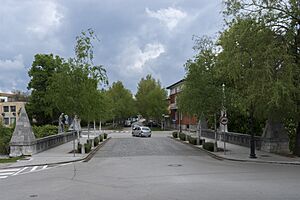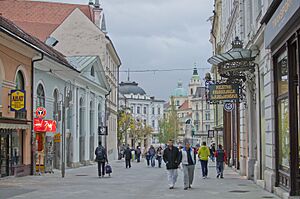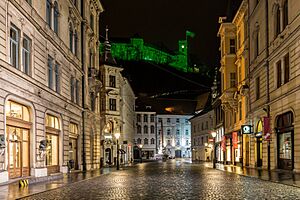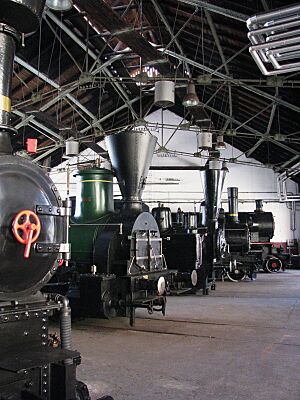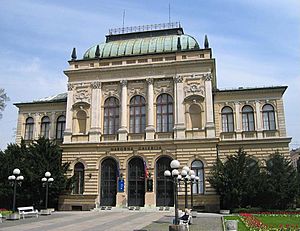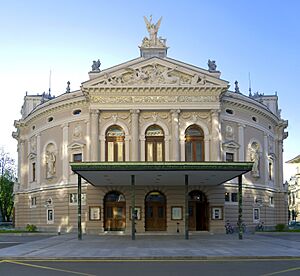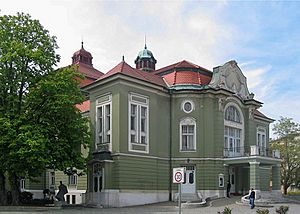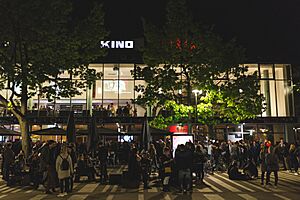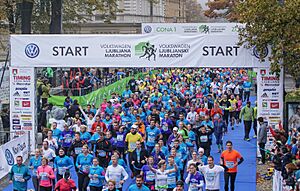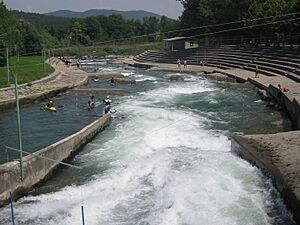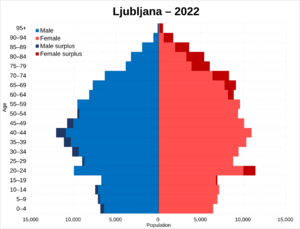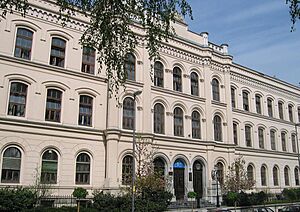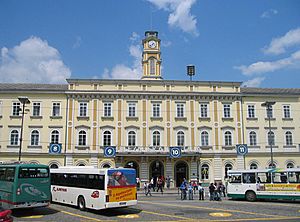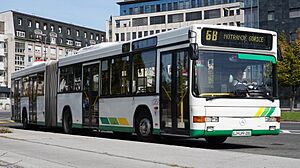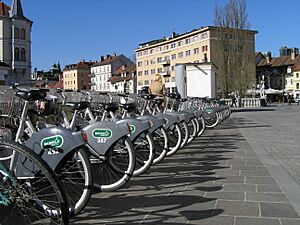Ljubljana facts for kids
Quick facts for kids
Ljubljana
|
|||
|---|---|---|---|
|
View of the city from Nebotičnik
Town Hall
Opera House
Dragon Bridge
Congress Square
|
|||
|
|||
| Country | |||
| Municipality | City Municipality of Ljubljana | ||
| Statistical region | Central Slovenia | ||
| First mention | 1112–1125 | ||
| Town privileges | 1220–1243 | ||
| Roman Catholic diocese | 6 December 1461 | ||
| Area | |||
| • Capital city | 163.8 km2 (63.2 sq mi) | ||
| • Metro | 2,334 km2 (901 sq mi) | ||
| Elevation | 295 m (968 ft) | ||
| Population | |||
| • Capital city | |||
| • Density | 1,712/km2 (4,430/sq mi) | ||
| • Metro | 537,893 | ||
| Time zone | UTC+1 (CET) | ||
| • Summer (DST) | UTC+2 (CEST) | ||
| Postal codes |
1000–1211, 1231, 1260, 1261
|
||
| Area code(s) | 01 (+386 1 if calling from abroad) | ||
| Vehicle Registration | LJ | ||
![]() Archbishop of Salzburg (1112–1555)
Archbishop of Salzburg (1112–1555)
![]() Habsburg Monarchy (1555–1804)
Habsburg Monarchy (1555–1804)
![]() Austrian Empire (1804–1809)
Austrian Empire (1804–1809)
![]() Illyrian Provinces (1809–1814; capital)
Illyrian Provinces (1809–1814; capital)
![]() Austrian Empire (1814–1867)
Austrian Empire (1814–1867)
![]() Austria-Hungary (1867–1918)
Austria-Hungary (1867–1918)
![]() State of Slovenes, Croats and Serbs (1918)
State of Slovenes, Croats and Serbs (1918)
![]() Kingdom of Yugoslavia (1918–1941)
Kingdom of Yugoslavia (1918–1941)
![]() Kingdom of Italy (1941–1945; annexed)
Kingdom of Italy (1941–1945; annexed)
![]() Nazi Germany (1943–1945; de facto)
Nazi Germany (1943–1945; de facto)
![]() SFR Yugoslavia (1945–1991)
SFR Yugoslavia (1945–1991)
![]() Slovenia (1991–present; capital)
Slovenia (1991–present; capital)
Ljubljana is the capital and largest city of Slovenia. It is located where important trade routes meet, between the northern Adriatic Sea and the Danube region. People have lived here since ancient times.
Ljubljana is the main center for culture, education, business, and government in Slovenia. A Roman city called Emona once stood here. The city was first mentioned in the early 1100s. It was the historical capital of Carniola, a part of the Habsburg monarchy where Slovenes lived.
Ljubljana was ruled by the House of Habsburg for many centuries, until 1918. After World War II, it became the capital of the Socialist Republic of Slovenia, which was part of Yugoslavia. When Slovenia became independent in 1991, Ljubljana remained its capital.
Contents
- What's in a Name?
- The Dragon Symbol
- Ljubljana's Story
- City Geography
- Cityscape and Architecture
- Green Spaces and Parks
- Culture and Arts
- Sports in Ljubljana
- Economy and Business
- Population and People
- Education in Ljubljana
- Science
- Transport in Ljubljana
- Healthcare
- International Connections
- Images for kids
- See also
What's in a Name?
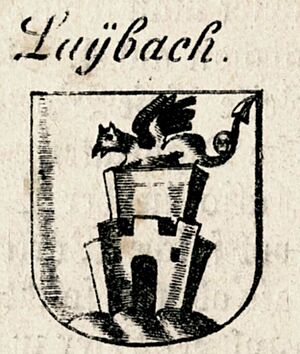
The exact meaning of the name Ljubljana is not fully known. In the Middle Ages, the river and town were also called Laibach in German. This name was used until 1918.
The German name was first written down in 1144. The Slovenian name appeared in records in 1146. Some experts think the name Ljubljana comes from the Slavic word ljub- meaning 'to love' or 'to like'.
Another idea is that it comes from Ljubija, the old name for the Ljubljanica River. This might be linked to an Old Slavic male name, Ljubovid, meaning 'the one with a lovely appearance'.
The Dragon Symbol
The symbol of Ljubljana is the Ljubljana Dragon. You can see it on top of the tower of Ljubljana Castle. It is also on the Dragon Bridge that crosses the Ljubljanica River. The dragon stands for power, courage, and greatness.
There are different stories about where the Ljubljana Dragon comes from. One Slavic myth says that killing a dragon helps water flow and makes the land fertile. This myth might be connected to the Ljubljana Marsh, a large swampy area near the city that sometimes floods.
Another story comes from Greek mythology. It says that the Argonauts, led by Jason, found a big lake and marsh near Ljubljana. Jason fought and defeated a monster there. This monster is believed to have become the dragon on the city's coat of arms and flag.
A more historical idea is that the dragon came from Saint George. He was the patron saint of the Ljubljana Castle chapel, built in the 1400s. In the legend of Saint George, the dragon often represents old beliefs being replaced by Christianity.
Ljubljana's Story
Ancient Times
Around 2000 BC, people lived in pile dwellings in the Ljubljana Marsh. These were houses built on stilts over water. Important discoveries from this time include prehistoric pile dwellings and the oldest wooden wheel in the world. These people hunted, fished, and farmed a little. They used dugout canoes to travel through the marshes. These ancient sites are now a UNESCO World Heritage Site.
Later, the area was a path for different groups, including the Illyrians and Celts.
The Roman City of Emona
Around 50 BC, the Romans built a military camp. This camp later grew into a city called Iulia Aemona. It was a strong fort with 5,000 to 6,000 people. Emona had plastered brick houses painted in different colors, connected to a drainage system.
In 452, the city was destroyed by the Huns, led by Attila. Later, other groups like the Ostrogoths and Lombards also attacked it. In the 500s, the ancestors of today's Slovenes moved into the area.
The Middle Ages
Ljubljana was first mentioned in writings between 1112 and 1125. The city grew around the castle of Ljubljana. In the late 1100s, people started to settle more permanently. Ljubljana gained town privileges (special rights for a town) between 1220 and 1243.
During the Middle Ages, the city faced seven big fires. Craftspeople formed guilds to protect their trades. In 1256, Ljubljana became the capital of Carniola. The city was owned by the House of Habsburg until 1797.
Early Modern Period

In the 1400s, Ljubljana became known for its art, especially painting and sculpture. The Archdiocese of Ljubljana was created in 1461. The Church of St. Nicholas became the main church.
After a big earthquake in 1511, the city was rebuilt in the Renaissance style. New walls were built around it. In the 1500s, Ljubljana had about 5,000 people. Most of them spoke Slovene. The first high school, public library, and printing house opened here.
From 1529, Ljubljana had a strong Protestant community. But in 1598, they were forced to leave. This started the Counter-Reformation, which brought back Catholicism. The Jesuits arrived in 1597 and helped build Catholic schools and promote Baroque music. Many Baroque buildings were constructed in the 1600s.
Recent History
From 1809 to 1813, during the time of Napoleon, Ljubljana was the capital of the Illyrian Provinces. In 1813, it returned to Austria. In 1821, Ljubljana hosted the Congress of Laibach, where European leaders met to decide political borders.
The first train arrived in 1849 from Vienna. In 1895, Ljubljana, with 31,000 people, was hit by a strong earthquake. Many buildings were destroyed. The city was rebuilt in the Vienna Secession style. Electric lighting came in 1898. This rebuilding period, from 1896 to 1910, is called the "revival of Ljubljana."
In 1918, after Austria-Hungary broke up, Ljubljana joined the Kingdom of Yugoslavia. During World War II, the city was occupied by Italy, then by Nazi Germany. From February 1942, the city was surrounded by barbed wire to stop resistance groups. After the war, Ljubljana became the capital of the Socialist Republic of Slovenia within Yugoslavia. It kept this role until Slovenia became independent in 1991.
Ljubljana Today
Today, Ljubljana is the capital of independent Slovenia. Slovenia joined the European Union in 2004.
City Geography
Ljubljana covers about 163.8 square kilometers (63.2 sq mi). It is in the Ljubljana Basin in Central Slovenia, between the Alps and the Karst region. The city has grown a lot since the 1970s.
Land and Hills
Ljubljana is on a flat plain. The mountains nearby are much older. Earthquakes have hit Ljubljana many times, especially in 1511 and 1895.
The city center is about 298 meters (978 ft) above sea level. Ljubljana Castle sits on Castle Hill, which is 366 meters (1,201 ft) high. The highest point in the city is Grmada, at 676 meters (2,218 ft). This is a popular spot for hiking.
Rivers and Ponds
The main rivers in Ljubljana are the Ljubljanica, the Sava, and the Gradaščica. The Ljubljanica partly flows through the Gruber Canal, built between 1772 and 1780. The lowest point of Ljubljana is where the Ljubljanica, Sava, and Kamnik Bistrica rivers meet.
Ljubljana has been affected by floods throughout its history. The southern and western parts of the city are more likely to flood. The Gruber Canal helps reduce flood danger in the Ljubljana Marsh.
The two main ponds are Koseze Pond and Tivoli Pond. Koseze Pond is a place for recreation and has rare plants and animals. Tivoli Pond is used for fishing.
Climate
Ljubljana has an oceanic climate with warm summers and moderately cold winters. July and August are the warmest months, with temperatures usually between 25 and 30 °C (77 and 86 °F). January is the coldest month, with temperatures around 0 °C (32 °F).
The city gets about 90 days of frost each year. It also has about 11 days with temperatures above 30 °C (86 °F). Rain falls fairly evenly throughout the year, but winter and spring are a bit drier. Thunderstorms are common from May to September. Snow usually falls from December to February, covering the ground for about 48 days a year. Ljubljana is also known for its fog, which happens on average 64 days a year, mostly in autumn and winter.
| Climate data for Ljubljana (Bežigrad District) 1991–2020 normals, extremes 1948–present | |||||||||||||
|---|---|---|---|---|---|---|---|---|---|---|---|---|---|
| Month | Jan | Feb | Mar | Apr | May | Jun | Jul | Aug | Sep | Oct | Nov | Dec | Year |
| Record high °C (°F) | 16.4 (61.5) |
22.3 (72.1) |
25.1 (77.2) |
29.3 (84.7) |
33.0 (91.4) |
36.8 (98.2) |
38.0 (100.4) |
40.2 (104.4) |
33.1 (91.6) |
27.0 (80.6) |
22.1 (71.8) |
17.4 (63.3) |
40.2 (104.4) |
| Mean daily maximum °C (°F) | 4.1 (39.4) |
7.0 (44.6) |
12.3 (54.1) |
17.2 (63.0) |
21.8 (71.2) |
25.8 (78.4) |
27.9 (82.2) |
27.6 (81.7) |
21.8 (71.2) |
16.1 (61.0) |
9.6 (49.3) |
4.2 (39.6) |
16.3 (61.3) |
| Daily mean °C (°F) | 1.0 (33.8) |
2.6 (36.7) |
7.1 (44.8) |
11.6 (52.9) |
16.1 (61.0) |
20.0 (68.0) |
21.8 (71.2) |
21.3 (70.3) |
16.1 (61.0) |
11.4 (52.5) |
6.4 (43.5) |
1.5 (34.7) |
11.4 (52.5) |
| Mean daily minimum °C (°F) | −1.7 (28.9) |
−1.2 (29.8) |
2.4 (36.3) |
6.3 (43.3) |
10.6 (51.1) |
14.4 (57.9) |
16.0 (60.8) |
15.9 (60.6) |
11.7 (53.1) |
7.9 (46.2) |
3.9 (39.0) |
−0.9 (30.4) |
7.1 (44.8) |
| Record low °C (°F) | −20.3 (−4.5) |
−22.5 (−8.5) |
−18.0 (−0.4) |
−3.3 (26.1) |
−1.0 (30.2) |
2.9 (37.2) |
6.0 (42.8) |
4.8 (40.6) |
−0.3 (31.5) |
−5.2 (22.6) |
−14.5 (5.9) |
−16.0 (3.2) |
−22.5 (−8.5) |
| Average precipitation mm (inches) | 67 (2.6) |
84 (3.3) |
83 (3.3) |
97 (3.8) |
114 (4.5) |
125 (4.9) |
122 (4.8) |
124 (4.9) |
160 (6.3) |
150 (5.9) |
138 (5.4) |
104 (4.1) |
1,368 (53.9) |
| Average extreme snow depth cm (inches) | 7 (2.8) |
8 (3.1) |
2 (0.8) |
0 (0) |
0 (0) |
0 (0) |
0 (0) |
0 (0) |
0 (0) |
0 (0) |
1 (0.4) |
3 (1.2) |
1.8 (0.7) |
| Average precipitation days (≥ 0.1 mm) | 11 | 10 | 11 | 14 | 14 | 14 | 13 | 12 | 13 | 13 | 16 | 14 | 153 |
| Average snowy days (≥ 0 cm) | 15 | 14 | 6 | 1 | 0 | 0 | 0 | 0 | 0 | 0 | 3 | 11 | 50 |
| Average relative humidity (%) (at 14:00) | 74 | 62 | 55 | 51 | 50 | 52 | 48 | 50 | 57 | 65 | 73 | 79 | 60 |
| Mean monthly sunshine hours | 72.6 | 102.5 | 155.6 | 188.7 | 232.3 | 253.2 | 288.4 | 264.6 | 175.6 | 115.3 | 56.3 | 55.1 | 1,960.2 |
| Source 1: Slovenian Environment Agency (humidity and snow 1981–2010), NOAA (sun 1991–2020) | |||||||||||||
| Source 2: OGIMET (some extreme values for 1948–present) | |||||||||||||
| Climate data for Ljubljana Airport, elevation 362 m (1188ft) (1991–2020 normals, extremes 1951-2020, snowy days 1981-2010) | |||||||||||||
|---|---|---|---|---|---|---|---|---|---|---|---|---|---|
| Month | Jan | Feb | Mar | Apr | May | Jun | Jul | Aug | Sep | Oct | Nov | Dec | Year |
| Record high °C (°F) | 18.2 (64.8) |
21.8 (71.2) |
24.2 (75.6) |
28.0 (82.4) |
32.6 (90.7) |
34.3 (93.7) |
36.1 (97.0) |
38.1 (100.6) |
31.1 (88.0) |
26.7 (80.1) |
21.9 (71.4) |
15.7 (60.3) |
38.1 (100.6) |
| Mean daily maximum °C (°F) | 3.5 (38.3) |
6.3 (43.3) |
11.4 (52.5) |
16.3 (61.3) |
20.9 (69.6) |
24.7 (76.5) |
26.7 (80.1) |
26.5 (79.7) |
20.9 (69.6) |
15.5 (59.9) |
8.9 (48.0) |
3.5 (38.3) |
15.4 (59.7) |
| Daily mean °C (°F) | −1.1 (30.0) |
0.3 (32.5) |
4.6 (40.3) |
9.5 (49.1) |
14.3 (57.7) |
18.3 (64.9) |
19.7 (67.5) |
19.2 (66.6) |
14.1 (57.4) |
9.5 (49.1) |
4.6 (40.3) |
−0.5 (31.1) |
9.4 (48.9) |
| Mean daily minimum °C (°F) | −5.0 (23.0) |
−4.6 (23.7) |
−1.2 (29.8) |
3.1 (37.6) |
7.6 (45.7) |
11.7 (53.1) |
13.1 (55.6) |
13.1 (55.6) |
9.0 (48.2) |
5.2 (41.4) |
1.3 (34.3) |
−3.7 (25.3) |
4.1 (39.4) |
| Record low °C (°F) | −27.3 (−17.1) |
−29.1 (−20.4) |
−24.7 (−12.5) |
−9.7 (14.5) |
−5.3 (22.5) |
−0.7 (30.7) |
2.2 (36.0) |
1.2 (34.2) |
−3.0 (26.6) |
−9.4 (15.1) |
−16.7 (1.9) |
−22.1 (−7.8) |
−29.1 (−20.4) |
| Average precipitation mm (inches) | 62 (2.4) |
77 (3.0) |
83 (3.3) |
90 (3.5) |
107 (4.2) |
129 (5.1) |
122 (4.8) |
129 (5.1) |
152 (6.0) |
137 (5.4) |
144 (5.7) |
109 (4.3) |
1,339 (52.7) |
| Average extreme snow depth cm (inches) | 9 (3.5) |
10 (3.9) |
4 (1.6) |
0 (0) |
0 (0) |
0 (0) |
0 (0) |
0 (0) |
0 (0) |
0 (0) |
1 (0.4) |
4 (1.6) |
2.3 (0.9) |
| Average precipitation days (≥ 0.1 mm) | 10 | 9 | 10 | 13 | 14 | 14 | 12 | 12 | 12 | 12 | 14 | 12 | 144 |
| Average snowy days (≥ 0 cm) | 16 | 14 | 8 | 1 | 0 | 0 | 0 | 0 | 0 | 0 | 3 | 12 | 54 |
| Average relative humidity (%) (at 14:00) | 76 | 64 | 57 | 54 | 52 | 54 | 52 | 53 | 60 | 67 | 76 | 81 | 62 |
| Mean monthly sunshine hours | 78 | 116 | 139 | 163 | 215 | 225 | 265 | 249 | 175 | 122 | 69 | 59 | 1,874 |
| Source: Slovenian Environment Agency | |||||||||||||
Cityscape and Architecture
Ljubljana's buildings show a mix of styles. The historic center has kept its old charm. After the 1511 earthquake, it was rebuilt in the Baroque style, like cities in Italy.
After the 1895 earthquake, it was rebuilt again. This time, the Vienna Secession style was popular. Famous architects like Jože Plečnik and Ivan Vurnik added their unique touches. Later, Edvard Ravnikar also helped redesign parts of the city.
Important Buildings and Squares
Prešeren Square is the main square in Ljubljana. It is home to the Franciscan Church of the Annunciation. This church was built between 1646 and 1660. It has a beautiful Baroque main altar.
Ljubljana Castle is a medieval castle on Castle Hill. It has parts from Romanesque, Gothic, and Renaissance times. The castle was built in the 1100s. Its Viewing Tower, from 1848, was used to announce important events. Today, it hosts cultural events and weddings. A funicular (a type of cable car) connects the city center to the castle.
Town Hall is where the city government meets. The original building was Gothic, built in 1484. It was later updated in the Baroque style. Near Town Hall is a copy of the Baroque Robba Fountain. The original is in the National Gallery.
Ljubljana Cathedral, also called St. Nicholas's Cathedral, is easy to spot with its green dome and twin towers. It was built between 1701 and 1706. The inside is decorated with Baroque frescos.
Nebotičnik (meaning "Skyscraper") is a thirteen-story building. It is 70.35 meters (230.8 ft) tall. It mixes Neoclassical and Art-Deco styles. The top floors have a café, bar, and observation deck. It was once the tallest residential building in Europe.
Green Spaces and Parks
Tivoli City Park is the biggest park in Ljubljana. It was designed in 1813. The park has trees, flower gardens, statues, and fountains. Inside the park, you can find Tivoli Castle and the National Museum of Contemporary History.
The Ljubljana Botanical Garden is the oldest cultural, scientific, and educational place of its kind in Slovenia. It started in 1810. It has over 4,500 types of plants. About a third of these plants are found only in Slovenia.
In 2014, Ljubljana won the European Green Capital Award for 2016. This was for its efforts to protect the environment.
Bridges, Streets, and Squares
Ljubljana has many famous bridges over the Ljubljanica River. These include the Dragon Bridge, the Butchers' Bridge, and the Triple Bridge.
The Dragon Bridge
The Dragon Bridge was built in 1901. It has dragon statues at its four corners. It has become a symbol of the city. It is a beautiful example of Vienna Secession style architecture.
The Butchers' Bridge
The Butchers' Bridge is decorated with bronze sculptures. These sculptures show scenes from Greek myths and Bible stories. It connects the Ljubljana Open Market area with restaurants. Many people attach love locks to this bridge.
The Triple Bridge
The Triple Bridge has three bridges side-by-side. It is decorated with stone railings and lamps. It connects the city center to Tivoli City Park and Ljubljana Castle. Two side bridges were added to the middle one to make it easier for people to cross.
The Fish Footbridge
The Fish Footbridge is made of transparent glass. It lights up at night with LEDs. It offers views of the Triple Bridge and the Cobbler's Bridge.
The Cobbler's Bridge
The 'Cobblers' Bridge' was built in 1930 by architect Jože Plečnik. It connects two old parts of medieval Ljubljana. It has two types of pillars: Corinthian and Ionic.
The Trnovo Bridge
The Trnovo Bridge is another famous work by Plečnik. It connects the old neighborhoods of Krakovo and Trnovo. It is known for its width and the two rows of birch trees it holds. It also has a statue of Saint John the Baptist.
The Hradecky Bridge
The Hradecky Bridge is one of the first hinged bridges in the world. It is the only preserved cast iron bridge in Slovenia. It was built in 1867.
Streets and Squares
Prešeren Square has been the city's main square since the 1800s. After the 1895 earthquake, it was redesigned. A statue of the Slovene national poet France Prešeren stands in the middle. The square is now a pedestrian zone, meaning no cars are allowed.
Republic Square is the largest square in Ljubljana. Slovenia declared its independence here on June 26, 1991. The National Assembly Building and Cankar Hall are located here.
Congress Square was built in 1821 for special events. It has been a center for political gatherings and protests. The University of Ljubljana Palace and the Philharmonic Hall are on this square.
Čop Street is a main street in the city center. It is named after Matija Čop, a literary figure. It is a pedestrian zone with shops and cafes.
Culture and Arts
Ljubljana's Unique Accent
The Ljubljana accent is a mix of different Slovene dialects. It has changed over time as more people moved to the city. This accent was important in shaping the standard Slovenian language. In the 1500s, Primož Trubar, a Protestant reformer, used Ljubljana's speech as the basis for the written Slovene language.
Ljubljana in Books and Films
Ljubljana appears in the 2005 novel The Historian by Elisabeth Kostova. It is also the setting for Paulo Coelho's 1998 novel Veronika Decides to Die. In 2010, UNESCO named Ljubljana the World Book Capital.
Festivals and Events
Each year, Ljubljana hosts over 10,000 cultural events. The Ljubljana Festival is one of the oldest festivals in the region, started in 1953. Many famous artists and orchestras have performed here. Other cultural places include Križanke and Cankar Hall.
During Book Week, events and book sales happen at Congress Square. A flea market is held every Sunday in the old city. On International Workers' Day, there is a celebration with a bonfire on Rožnik Hill.
Museums and Art Galleries
Ljubljana has many art galleries and museums. The first art gallery was the Jakopič Pavilion. Today, you can find museums for architecture, railways, schools, sports, modern art, and even a brewery.
The National Gallery of Slovenia and the Museum of Modern Art show works by important Slovenian artists. The Metelkova Museum of Contemporary Art opened in 2011.
Entertainment and Performing Arts
Cankar Hall is Slovenia's largest cultural and congress center. It hosts film festivals, performances, and book fairs.
Cinema
Movies became popular in Ljubljana in the early 1900s. After World War II, a company called Ljubljana Cinematographers managed many movie theaters. Today, most movies are shown at Kolosej, a large multiplex cinema. Art films are shown at Kinodvor. The Slovenian Cinematheque hosts the international Ljubljana LGBT Film Festival.
Music and Theatre
The Slovenian Philharmonics is a central music group in Ljubljana. It holds classical music concerts. The Slovene National Opera and Ballet Theatre performs opera, ballet, and concerts. Music festivals, like the Ljubljana Summer Festival, are also held.
Theatre has a long history in Ljubljana. The first Slovene-language play was performed in 1867. There are many small theatre groups and a popular puppetry theatre.
Dance
Modern dance first appeared in Ljubljana in the late 1800s. The Ljubljana Dance Theatre is dedicated to contemporary dance. There are also several folk dance groups.
Jazz
The Ljubljana Jazz Festival is held every July. It is part of the European Jazz Network. It features artists from many countries.
Urban Culture and Alternative Scene

In the 1980s, new subcultures led to the growth of an alternative culture in Ljubljana. This led to the creation of alternative art centers.
- Metelkova and Rog
Metelkova is a self-declared independent neighborhood. It was once an old army barracks. Now, its buildings are art galleries, artist studios, and nightclubs. Celica Hostel is next to Metelkova. Another alternative center is the former Rog factory. In 2023, the Rog factory was renovated and is now called Center Rog. It has studios, apartments, a library, and shops.
- Šiška Cultural Quarter
The Šiška Cultural Quarter hosts groups focused on modern and experimental arts. Kino Šiška Centre for Urban Culture holds concerts and exhibitions. The Museum of Transitory Art (MoTA) organizes the Sonica Festival.
Sports in Ljubljana
Sports Clubs
In the 1800s, sports in Ljubljana were influenced by both German and Slovene residents. The first sports club, the South Sokol Gymnastic Club, was founded in 1863. It encouraged Slovene independence.
The first cycling club was started by German residents in 1885. Slovene cyclists then formed their own club in 1887. The first Slovene Alpine club was founded in 1893.
Today, Ljubljana has football teams like NK Olimpija Ljubljana and NK Bravo. Ice hockey clubs include HK Slavija and HK Olimpija. Basketball teams are KD Slovan, KD Ilirija, and KK Cedevita Olimpija. The RK Krim women's handball team has won the EHF Champions League twice.
Mass Sport Activities
Every year in May, the recreational Walk Along the Wire takes place. It marks the liberation of Ljubljana in 1945. The Ljubljana Marathon is held every October. Thousands of runners take part.
Sport Venues
The Stožice Stadium, opened in 2010, is the biggest football stadium in Slovenia. It is home to NK Olimpija Ljubljana. The park also has an indoor arena for basketball, handball, and volleyball.
Šiška Sports Park has a football stadium, athletic areas, and tennis courts. The Tacen Whitewater Course, on the Sava River, hosts major international canoe/kayak competitions.
There is a ski slope in Gunclje, in the northwestern part of the city. It is 600 meters (2,000 ft) long. Several Slovenian Olympic medalists have trained there. Ice rinks can be found at Koseze Pond and Tivoli Hall.
Economy and Business
Industry is a major employer in Ljubljana, especially in pharmaceuticals, petrochemicals, and food processing. Other important areas include banking, finance, transport, construction, and tourism. The public sector provides jobs in education, healthcare, and government.
The Ljubljana Stock Exchange handles business for large Slovenian companies. Many companies have their main offices in Ljubljana. These include the retail chain Mercator and the oil company Petrol d.d.. Over 15,000 businesses operate in the city.
BTC City is the largest business, shopping, and entertainment center in Slovenia. It covers 475,000 square meters (5,110,000 sq ft). About 21 million people visit it each year.
Population and People
Ljubljana has about 300,000 people as of 2024. In 1869, it had about 22,600 residents. By 1931, this grew to almost 60,000.
In 2002, about 39% of Ljubljana's people were Catholic. About 91% of the population speaks Slovene as their main language. The next most common languages are Bosnian and Serbo-Croatian.
Education in Ljubljana
Elementary Schools
Ljubljana has over 50 public elementary schools with more than 20,000 students. There is also an international elementary school. Two private schools are a Waldorf school and a Catholic school.
The first school in Ljubljana was in the 1200s. In 1775, the Austrian Empress Maria Theresa made elementary education required.
Secondary Schools
Ljubljana has ten public and three private grammar schools. Public schools are free. Some schools offer special programs for sports or international studies. All grammar schools last four years and end with the matura exam.
In the 1500s, the Carniolan Estates' School was founded. It taught in Latin, Greek, German, and Slovene. Later, the Jesuits opened a college.
Higher Education

The University of Ljubljana is Slovenia's most important university. It was founded in 1919. It has 23 faculties (departments) and three academies. They offer courses in medicine, science, arts, law, and other subjects. Over 63,000 students attend the university. Students make up a big part of Ljubljana's population.
Libraries
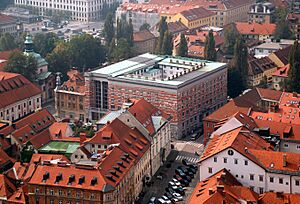
The National and University Library of Slovenia is the country's main library. In 2011, it held over 2.6 million items, including books and manuscripts.
The Central Technological Library is the second largest university library. It focuses on natural sciences and technology. The City Library of Ljubljana is the largest public library. It has 36 branches.
The first libraries in Ljubljana were in monasteries. The first public library was started in 1569.
Science
The first group of scientists and public workers in Carniola was the Dismas Fraternity, formed in 1688. The Academia Operosorum Labacensium was founded in 1693. The Slovenian Academy of Sciences and Arts was established in 1938.
Transport in Ljubljana
Air Travel
Ljubljana Jože Pučnik Airport is about 26 kilometers (16 mi) northwest of the city. It has flights to many European cities. Airlines like Air France, Lufthansa, and Turkish Airlines fly from there.
Train Travel
Ljubljana is a major train hub. Important European railway lines cross here. All international passenger trains stop at the Ljubljana railway station. The city has six passenger train stations. The Ljubljana Castle funicular connects the city center to Ljubljana Castle.
Roads
Ljubljana is where Slovenia's two main highways meet. These highways connect the city to other parts of Europe. The city center has been closed to most cars since 2007, creating a pedestrian zone.
Public Transport
Ljubljana used to have a tram system, but it was replaced by buses. The city bus network is the most common way to get around. Bus rides can be paid for with the Urbana payment card.
The Cavalier is an electric shuttle bus that operates in the car-free zone of the city center. It is free and can be stopped anywhere. It is popular with older people and tourists. There is also a trackless train for tourists that goes to Ljubljana Castle.
Bicycles
Many people ride bicycles in Ljubljana, especially in warmer weather. The BicikeLJ system allows people to rent bicycles. It has 600 bicycles and 60 stations. The first hour of rental is free. Ljubljana is considered one of the most bicycle-friendly cities in the world.
Water Transport
In the past, rivers were used to transport goods. Today, the Ljubljanica River is used by tourist boats.
Healthcare
Ljubljana has a long history of medical discoveries. The Ljubljana University Medical Centre is the largest hospital in Slovenia. The Faculty of Medicine and the Ljubljana Institute of Oncology are also important medical institutions. Ljubljana is part of the WHO European Healthy Cities Network.
International Connections
Twin Towns and Sister Cities
Ljubljana is twinned with many cities around the world:
|
Images for kids
See also
 In Spanish: Liubliana para niños
In Spanish: Liubliana para niños







